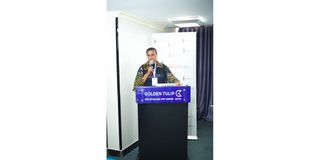Hope for children with cleft lips in Tanzania as treatment access improves

Smile Train Vice President and Regional Director for Africa, Nkeiruka Obi, addresses a stakeholder forum on improving cleft care in Tanzania. PHOTO|HARIETH MAKWETTA
What you need to know:
- Statistics show that over 3,000 children are born with cleft-related conditions in Tanzania every year. Yet, the country currently has only 15 centres offering such treatments and just 27 specialist surgeons.
Dar es Salaam. Children born with cleft lips and palates now have greater hope of returning to normal lives, thanks to improved, staged treatment options that have been available in Tanzania for the past 22 years.
Statistics show that over 3,000 children are born with cleft-related conditions in Tanzania every year. Yet, the country currently has only 15 centres offering such treatments and just 27 specialist surgeons.
Speaking during a stakeholder forum on Monday, July 28, 2025, at Bugando Medical Centre, consultant plastic surgeon Dr Francis Tegete said that treatment for cleft lip and palate now begins from birth and continues until the age of 22.
“These step-by-step treatments represent the global standard. At each stage, specific procedures are offered, and by adolescence or adulthood, we can even reconstruct the nose to match the symmetry of the midface,” said Dr Tegete.
He highlighted the transformative impact of services provided by Smile Train, an international charity supporting children with cleft conditions.
“In the past, treatment was limited. Now, we walk with the patient through the full journey. There’s also a large group who missed treatment during childhood—we are not leaving them behind. They are also eligible for corrective surgery,” he added.
The forum brought together key health stakeholders, including surgeons, anaesthetists, nurses, medical associations, government officials, and affected individuals, to explore innovative and sustainable ways of improving cleft care in Tanzania.
Nkeiruka Obi, Smile Train’s Vice President and Regional Director for Africa, applauded Tanzania’s strides in strengthening health infrastructure and human resource capacity in cleft care.
“Since 2006, we’ve transformed the lives of more than 15,000 people in Tanzania through safe, high-quality cleft surgeries in collaboration with over 15 hospitals—many of which are government-run,” she said.
Obi noted that innovations such as solar-powered surgical systems have reduced operational costs and ensured uninterrupted services even during power outages.
“Beyond infrastructure, we’ve trained over 1,000 health workers in areas like nursing, AHA protocols, SAFE training, nutrition, and comprehensive cleft care—equipping them to deliver world-class services where they are most needed,” she said.
Dr Mugisha Nkoronko, President of the Medical Association of Tanzania, who officiated the forum, acknowledged Smile Train’s support and said the government continues to roll out nutrition programmes for maternal and child health.
“Smile Train complements President Samia Suluhu Hassan’s efforts to expand cleft care services. Malnutrition delays surgery, increases anaesthetic risks, slows healing, and places further strain on an already challenged healthcare system,” he said.
He added that Tanzania is currently reviewing its National Surgical, Obstetric and Anaesthesia Plan (NSOAP) and is developing a second strategic roadmap aimed at achieving equitable and sustainable surgical services.
Dr Nkoronko called for cross-sectoral cooperation to scale up cleft services. “Cleft care requires the collaboration of health, education, nutrition, and social welfare sectors—even across borders. Together, we must ensure that every child born with a cleft in Tanzania gets timely and safe surgery, along with the necessary support to thrive,” he said.
Smile Train recently launched a Cleft Leadership Centre (CLC) at Komfo Anokye Teaching Hospital (KATH) in Kumasi, Ghana, as part of its commitment to building local, expert-led cleft care globally. The 30,000-square-foot facility is the largest cleft care centre in Africa.
In Tanzania, Bugando Medical Centre remains the leading partner hospital where Smile Train has invested heavily. However, Dr Tegete emphasised the need for additional support to overcome existing challenges.
He noted that cleft conditions are associated with social stigma, difficulty in feeding, speech and hearing complications, poor physical appearance, and malnutrition-related fatalities.
“Many families lack awareness, and access to trained professionals is still limited. Nutritional specialists are scarce, and geographic challenges prevent some from reaching care centres,” he said.
Dr Tegete also urged the government to formally recognise cleft care in national policy frameworks to enhance resource allocation and planning.
Causes and cases
According to Dr Tegete, cleft conditions often have no single cause but may result from a combination of hereditary and environmental factors.
“If one of the parents—or even a grandparent—had a cleft condition, there's a chance the child could inherit it, especially in second-generation births. Also, if a mother uses alcohol or certain substances between weeks five and 12 of pregnancy, it may contribute,” he said.
He recommended the use of folic acid and vitamin A supplements to help reduce the risk and encouraged planned pregnancies, noting that many expectant mothers realise they are pregnant after the crucial early weeks of foetal development.
Among the programme’s beneficiaries is Boniface Ndamgoba, who underwent his first cleft surgery over 35 years ago and recently received a follow-up operation through Smile Train.
Tumaini John from Tanga, whose one-year and eight-month-old child also underwent surgery through the programme, shared his gratitude.
“I saw the announcement, made the call, and my child received the first surgery in September last year. The second procedure was done this year, and now they are planning another corrective surgery,” he said.




